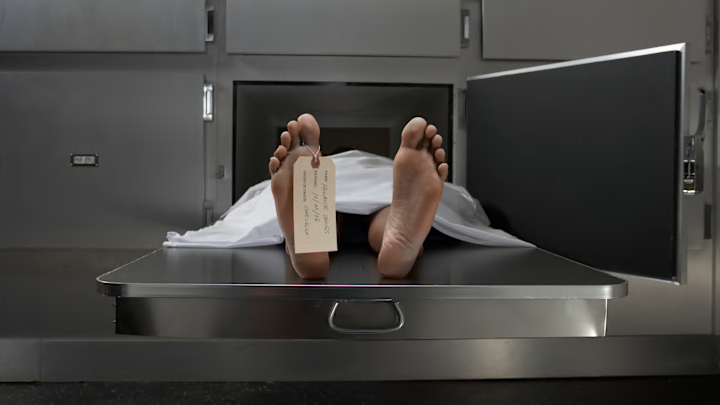Bodies are weird enough, but it's the dead ones that hold real intrigue. The fact that most of us just don't spend that much time around them means it's hard to separate truth from fiction. Corpses have been thought to be responsible for plagues and to carry magic healing properties. Below, some dead body myths that won't give up the ghost—and explanations of the real-life science behind them.
1. Hair and nails grow after death.

Not true! The cell division driving hair and nail growth stops when the body dies and the heart no longer pumps oxygen-filled blood throughout the circulatory system. It does look like things keep growing, though. When a dead body's skin loses hydration, it retracts—and retraction along the nail bed makes it appear as if the nails are getting longer. As for hair, drying skin on the face and head "pulls back towards the skull, making stubble appear more prominent," writes Claudia Hammond for the BBC. "Goosebumps caused by the contraction of the hair muscles can add to the effect."
2. Dead bodies are dangerous ...
There's no science to back up the idea that a dead and decomposing body is harmful to the living just by virtue of its being dead. This might sound obvious, but the belief that disease came from breathing in air infected by corpses was once common.
The miasma theory, as it was called, was a widespread belief among members of the medical profession (and the public) in the 19th century. Miasma, an ancient Greek word for “pollution,” was the bad air coming from “rotting corpses, the exhalations of other people already infected, sewage, or even rotting vegetation” and was thought to be responsible for the spread of disease, according to a 2001 paper in BMJ. Fortunately, this belief was eventually replaced by germ theory.
3. … And multiple dead bodies are extra dangerous.
In a 2005 publication from the Pan American Health Organization (a division of the World Health Organization), Donna Eberwine explained that the belief that dead bodies spread disease "remains a chronic problem in disaster relief efforts." After natural disasters, there is often hysteria around dead bodies and a rush to immediately bury them, which distracts relief efforts from more pressing concerns. "The microorganisms that are involved in decomposition are not the kind that cause disease," Eberwine writes. "And most viruses and bacteria that do cause disease cannot survive more than a few hours in a dead body."
There are some exceptions. The level of Ebola virus in dead victims can remain high, and their remains should only be handled by people in protective gear (and buried quickly). HIV can live for up to 16 days in a body held under refrigeration, and other blood-borne viruses like hepatitis, along with tuberculosis and gastrointestinal infections, can pose a risk. "The risk of contagion can be minimized with basic precautions and proper hygiene," Eberwine wrote.
4. Embalming makes dead bodies safer.

"Embalming provides no public health benefit," according to the Funeral Consumer's Alliance (a nonprofit focused on affordable death care), citing the CDC and Canadian authorities. While individual morticians might say that a body must be embalmed before viewing or burial, the process is not legally required if the body will be cremated or refrigerated for viewing prior to burial or cremation. Moreover, since a dead body is usually not in itself harmful, embalming does not make it any safer. On the flip side, embalming chemicals are actually quite toxic, and embalmers must cover their entire body and wear a respirator while working.
5. Dead bodies sit up on the medical table.
This horror-movie trope just isn't real. During decomposition, a body might twitch or make small movements and noises due to the gas and waste released by bacteria. A decomposing corpse can definitely move a little, but sitting straight up is just not going to happen.
6. Burying a body without a coffin or vault will contaminate groundwater.
Nope! Burials usually occur at 3.5 feet below the ground’s surface, whereas potable water can be 75 feet underground. "Mandatory setbacks from known water sources also ensure that surface water is not at risk," the Green Burial Council explains [PDF]. Additionally, because microorganisms living in the soil will break down the chemical compounds that remain in a dead body, we actually give out "more toxic chemicals during a day of living than a whole body will decomposing."
7. Cremains are ash.

Though we often talk of "scattering ashes," cremains are a little more complicated. Once a body intended for cremation has been burned in what's called a retort, what's left will be put in a cremulator. Sort of like a blender, the cremulator uses ball bearings or rotating blades to pulverize the bones and other remnants into a "grayish, coarse material, like fine gravel," as HowStuffWorks puts it.
8. Maybe death isn’t as scary as we think.
According to psychological scientist Kurt Gray, it's possible that death isn't quite as terrifying as we think it is. Gray studied the responses of death row inmates and terminally ill patients as well as those of people asked to imagine they had untreatable cancer, and found that "while it's natural to fear death in the abstract, the closer one actually gets to it, the more positive he or she becomes," as New York Magazine explains. This may be due to something called the "psychological immune system," a term coined by Harvard psychologist Dan Gilbert in his book Stumbling on Happiness. According to Gray, our psychological immune system is engaged when bad things happen. "So when one is faced with death, all sorts of rationalization and meaning-making processes come in," he told New York Magazine. That may sound like your brain's trying to give you a cop-out, but it's much better than living in terror.
A version of this article was published in 2017; it has been updated for 2024.
